Season 4 of Stranger Things subjected the kids from Hawkins, Indiana, to some of the scariest experiences they’ve had so far (which is saying a lot) as they battled a new threat from the sinister dimension known as the Upside Down. It also tested the mettle of the show’s visual effects teams, which were tasked with delivering the Netflix hit’s most massive, explosive scenes so far, as well as some of its most gruesome, nightmarish environments.
Among the visual effects studios to work on Stranger Things season 4 was Scanline VFX, an Emmy-winning and Oscar-nominated studio responsible for creating movie magic in HBO’s Game of Thrones and Marvel’s Captain America: The Winter Soldier, among other projects. The Scanline team created more than 220 shots across eight episodes of the season, including the grisly aftermath of the massacre at Hawkins Lab and various elements of the Upside Down and the portal-like “rifts” between our world and that dark dimension. To find out more about their work on the season, Digital Trends spoke to Justin Mitchell, Scanline’s VFX supervisor on Stranger Things.
[Note: The following interview includes a discussion of key plot points — and surprises — from season 4 of the series.]

Digital Trends: Your team worked on the interior of Hawkins Lab after almost everyone is wiped out, with all the blood and bodies and destruction. What does that sort of work entail? It seems gruesome.
Justin Mitchell: Most of our work in that sequence involved digital matte painting. There had been a massacre, and there were orderlies and kids that were all dead on the floor, and blood and cracked tiles on the walls where people had been smashed up against them. And there was a lot of disfigurement everywhere, broken limbs and such, because when One — or Vecna — kills his victims, he does so by snapping their arms and legs and poking their eyes in, which is pretty macabre.
With the kids, we would create digital, three-dimensional digital representations of them, then create a matte painting of their limbs in a broken state. That’s because when they were actually filmed, the kids were in disfigured-looking poses, but there were no prosthetics and very little makeup work done. So the work largely involved trying to show that their bones had been broken, as well as augmenting the damage in that space.
It’s more than just adding some blood splatter.
Definitely, yeah.
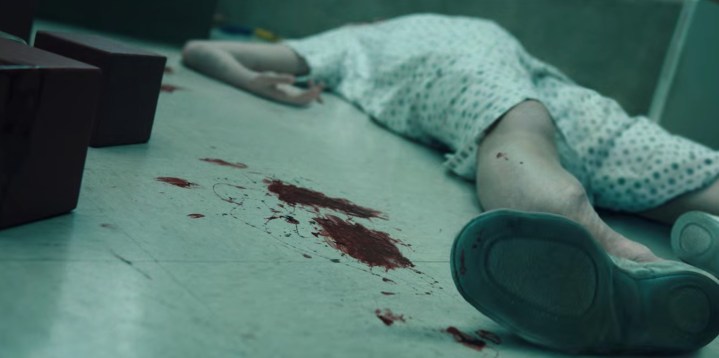
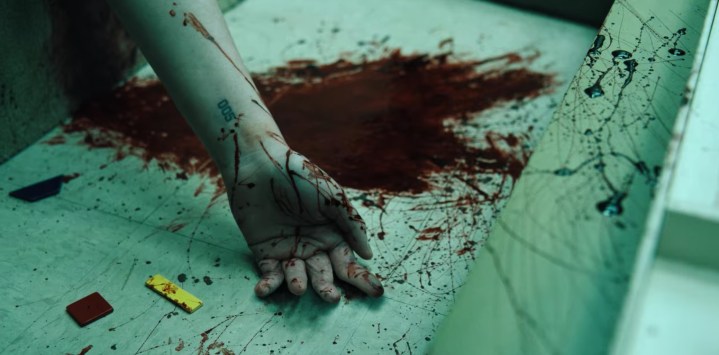
Jumping ahead a bit, your team also worked on the rift to the Upside Down we see in Eddie’s trailer, and a few others that appear throughout the season. What went into creating the look of those elements?
Yeah, the rifts were definitely a recurring theme for us in this season. We created rifts of all shapes and sizes, and the rifts had to not only appear, but travel through all manner of different materials. [They had to go through] the boards in an attic floor, through people, through Eddie’s trailer, and through the landscape and trees and buildings, ultimately colliding in downtown Hawkins. There was even a rift that went through a lake.
So we had to really explore how to create some connective tissue between all of those different rifts and make them all consistent. It was largely based on established precedent from previous seasons. The rifts had appeared in those seasons, so we borrowed from the language that was already established, but they really hadn’t been seen on this scale or moving quite in the way that we pictured them this season.
It’s one thing for them to be present, but for them to actually move changes things, I assume.
It does. The elements that made up the rifts were often a sort of rigid-body simulation if it was a building that was collapsing into a rift or ground that was opening up, or wood planks that were shattering. But then there was the fleshy kind of mold that grew out from the sides of the rifts, which was actually helpful in creating a sort of transition zone between the actual photography in the shot and the CG elements.
There were also the vines that crawled up from the Upside Down, through the rift opening. The vines are a very important part of Stranger Things, particularly in this season as they operate as an extension of Vecna, part of his hive mind. And there was also the membrane — a kind of a fleshy barrier that spans the width of a rift. The membrane basically serves as a doorway between the right side up and the Upside Down, and once you pass through that membrane, you’re on the other side of that world.

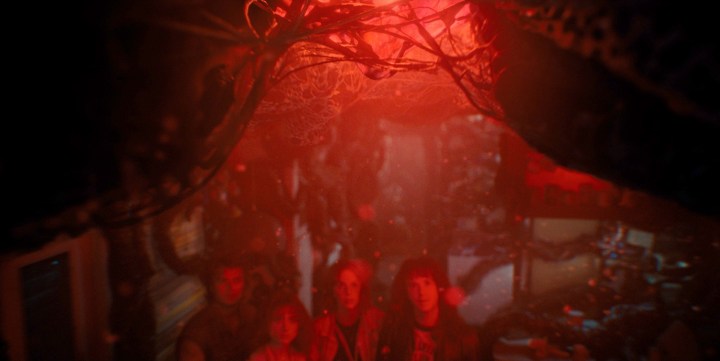
And then you have to light all of it, too.
Right. That red, amber light that shines up from the rifts was an important part of the language of that universe, particularly because a lot of our scenes were set at night and it was important to show the rifts traveling, which was sometimes difficult to do in the dark. That red light worked to put light on the rift itself, but also to illuminate neighboring buildings or trees, that kind of thing.
Particularly for the rifts, it seems like you had to blend a lot of elements introduced in earlier seasons into a single, cohesive shot. Is that accurate?
I think that’s fair to say, yeah. I hadn’t worked on Stranger Things previously, but our company did work on season three in the underground Russian base where they were carving the rift. We did a lot of research and tried to build off the existing lore of Stranger Things. As a show, they’ve grown a lot. Early on, the budgets were pretty small and a lot of things were done in a practical way. Now they’re a flagship product of Netflix, so the budgets are more significant and there are more hands on deck and there’s more time, so we try to up the ante a bit.

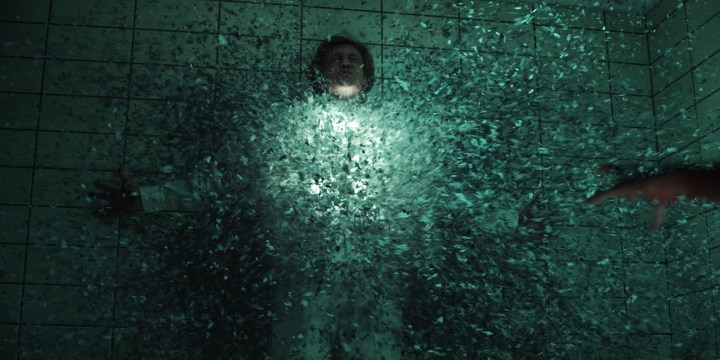
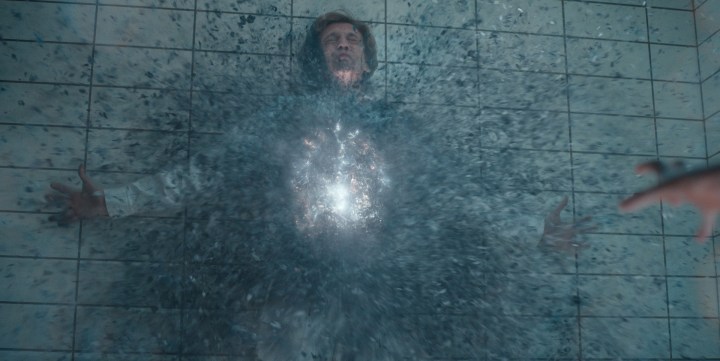
Your team did a lot of work on episode 9, including interiors of the Creel house with its vines and creepy atmosphere. What went into creating that haunted-house vibe?
They actually had the Creel house on set, so we created a digital replica of what existed, rather than creating the whole thing. What we did in the Creel House primarily was to add the vines that the kids carefully step over…
Until they don’t…
Yeah, exactly. It doesn’t work out so well. Ultimately, they get grabbed by those vines and held up against the wall, but of course, they manage to escape. So, the vines were all animated. There were some practical vines that were dressed on the set, and the art department did put vines on the walls, too, so we tried to match the aesthetic that was there. But the vines dressed on set didn’t actually move, whereas ours moved. So we had to match the vines and the nether stretch, which are both important aspects of Stranger Things…

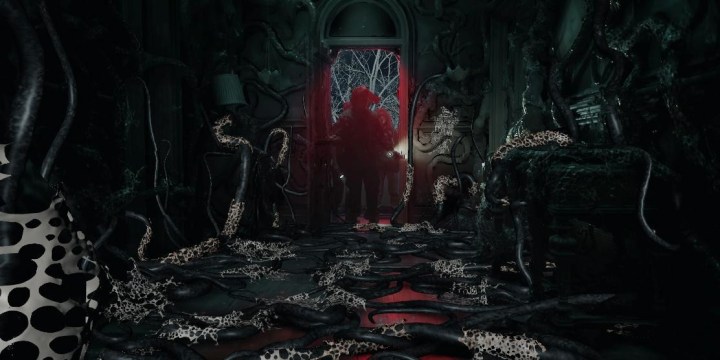
The nether stretch?
Yeah, that’s the stuff that’s almost like a snake skin — that webby structure that often appears at the edges of rifts and around vines. It’s actually made out of melted bubble wrap. We created a digital representation of it, but on set that’s how it’s made. So we had to create some digital nether stretch in our sequences, too. You can see it in Eddie’s trailer when the rift is expanding out, and the scenes where the kids are traversing through the rift. It also appears in the Creel house and the rainbow room sequence where Eleven is fighting One and ultimately carves a rift through him into the wall behind him.
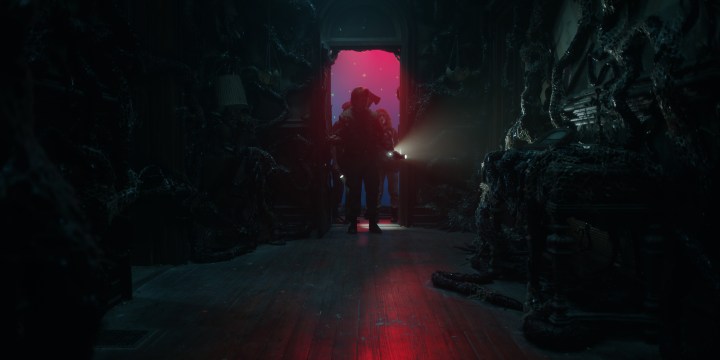
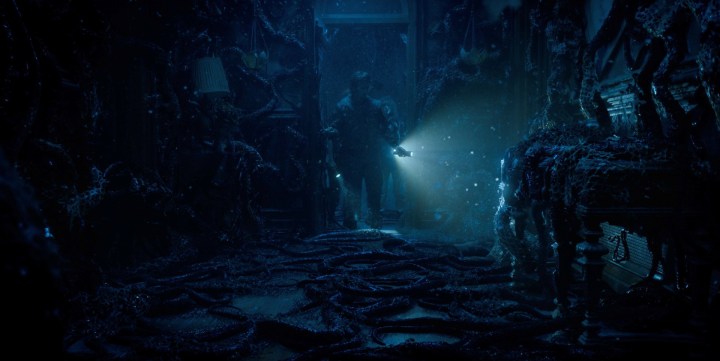
You mentioned this scene earlier, but tell me more about the big, season-ending destruction sequence with Hawkins being ripped apart by the four rifts coming together. You had to create that in a nighttime setting and then we see it again in the daylight. How did that scene evolve?
We had a digital representation of Hawkins, and sometimes there were [camera-shot] plates that were used in it, and some was fully CG. That gave us control over the lighting, but we had to bend the language of the environment a bit to make it work in daytime. The red lighting doesn’t play so well [in the daytime], for example, because it’s competing with daylight. The tradeoff there is that you get to see the reflectivity of the fleshy mold and the physical nature of the vines and their sliminess in the daytime. But it was all based on the same set-up and language, ultimately.
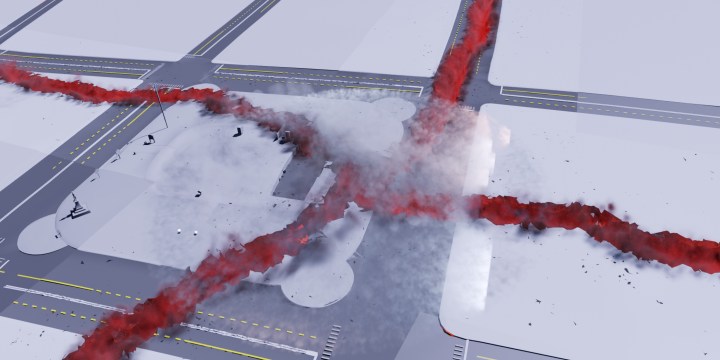
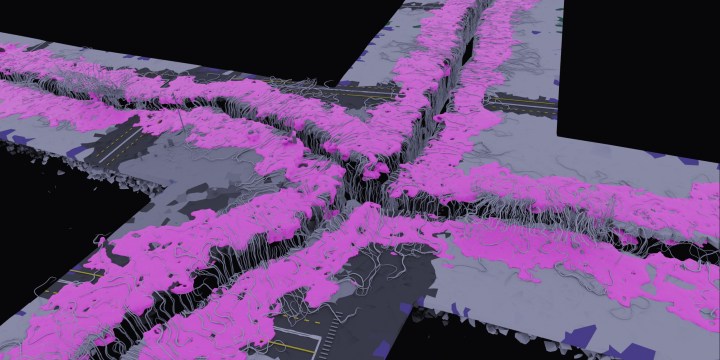


Were there any shots that turned out to be trickier than you anticipated? Any unexpected challenges that arose with particular scenes?
There are always challenges, but it’s often not the things you expect. That big penultimate sequence in Hawkins had a lot of complex elements and layers to work on, so that was complex, but that’s different from actually being troublesome. The Creel house sequence was challenging, though, because when they shot that sequence, there was a lot of atmosphere in the real set and the kids were walking around with flashlights and shining them on the vines to look where they’re going. We had to match all of that flashlight movement so that the lighting on the CG elements changes when they were hit by the flashlights in the same way the practical elements were lit up on set.
What made it especially tricky was that a flashlight’s beam also illuminates the dust or smoke in the air. We were layering [visual effects] elements in front of the kids and behind them as they’re walking around, and we also had to match the density of the atmosphere and the light passing through it along with the lighting on the actual surfaces. Those things were some of the trickier things to properly integrate.
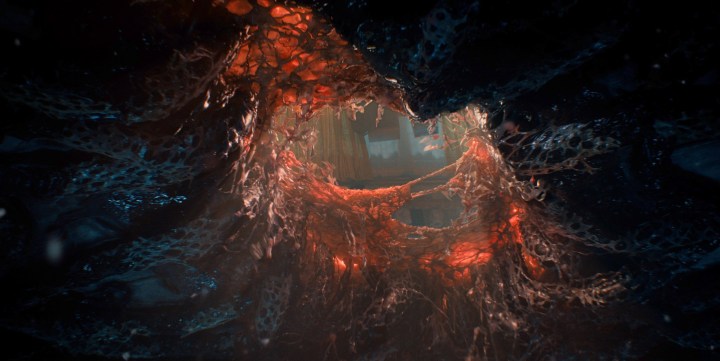
Finally, I have to ask: What’s it like to work on a project as big as Stranger Things? It’s such a cultural touchstone now that it has to feel a little different on the inside of it.
I couldn’t be happier. It was awesome. I was thrilled to get the opportunity to work on Stranger Things. It’s a show that I’ve loved regardless of the visual effects, which have been really stellar across seasons. I’m a fan. I remember the ’80s as the heyday of my teenage years, so having that in the backdrop just adds to the joy of watching the show. I think the Duffers have done an awesome job in creating a balance in genres and styles somewhere between Steven Spielberg and Stephen King.
The horror-adventure genre is a lot of fun and the storytelling is excellent. It is a little bittersweet sometimes as a visual effects artist working on something you truly enjoy, though, in that you get the spoilers and kind of know what’s going to happen before everyone else does. But I was really thrilled to work on the show and it was a great experience.
Season 4 of Stranger Things is available now on Netflix.
Editors’ Recommendations
Credit: Source link


Comments are closed.